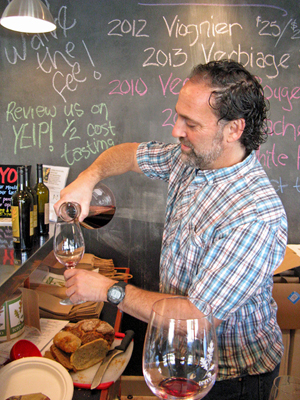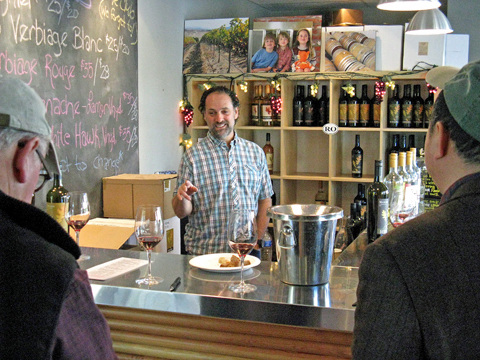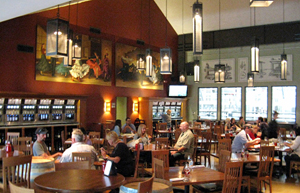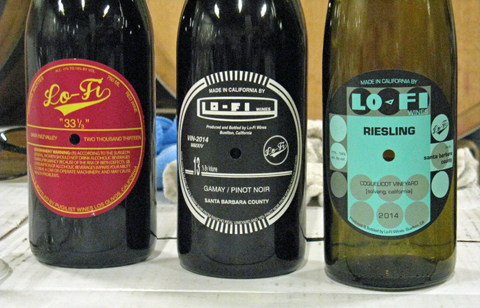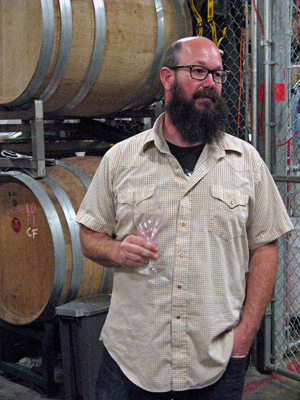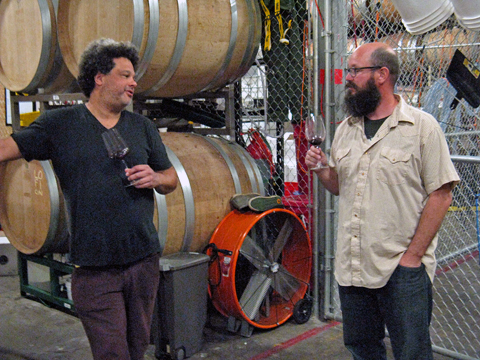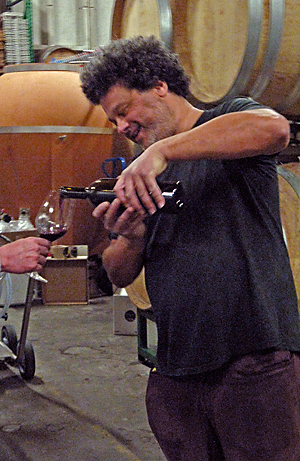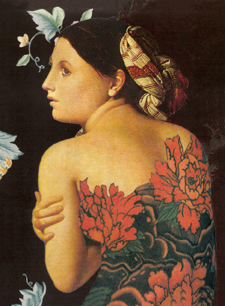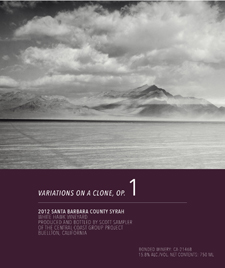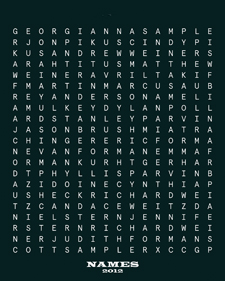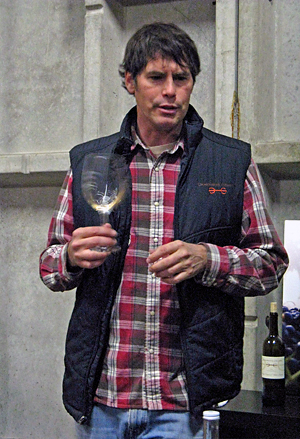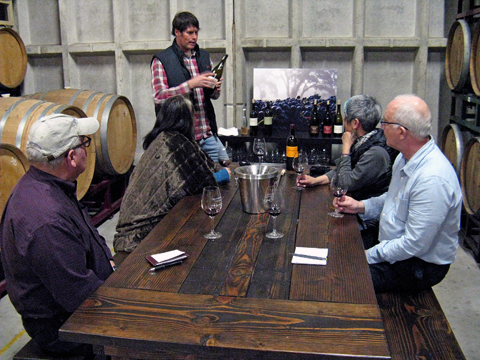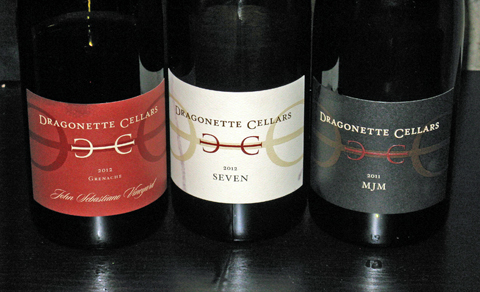Central Coast - January 2015 - Part 4
Our wine-touring group (Eric, Alan, Jane, Warren, Mary, and me) had settled into our Solvang timeshare units, which were in an ideal central location for our visits in Santa Barbara County wine country.
Eric and Mary both were up early on Monday morning to start the prep work for Mary’s broccoli, mushroom, and cheese frittata. We enjoyed that along with bacon and more of the banana bread and cranberry scones that we’d started on the day before. The timeshare unit was pretty well-stocked with cookware, dishes, and utensils, though they provided the smallest salt and pepper shakers any of us had ever seen. Mary sent me on an expedition to the front desk for another set of them – hope they didn’t charge Jane extra for those!
It was another bright, sunny morning and we had plenty of time to relax before our first wine-tasting appointment. Our itinerary for the whole trip worked out pretty efficiently, and for the most part we managed to avoid having to make any lengthy drives out to one spot and then doubling back for the next one. Once again, our first destination of the day was not far away, about a 15-minute drive to the town of Los Olivos in the heart of Santa Ynez Valley.
| Monday
- January 19, 2015 |
Tercero Wines
Tasting Notes: Current Releases and Tank Samples |
Tercero 2012 Grenache Blanc, Camp 4 Vineyard, Santa Ynez Valley. Very light straw color, with green apple, fresh herbs, and a light touch of petrol on the nose. Medium-light bodied with vibrant acidity and a crisp finish, nice.
Tercero 2013 “Verbiage Blanc,” Santa Barbara County. 42% Roussanne, 29% Grenache Blanc, 29% Viognier. Light straw color, this showed spice and floral aromas with support from stone fruit and a leesy note. Moderately rich texture with very good balancing acidity and a long, clean finish, nice.
Tercero 2013 Roussanne, Santa Ynez Valley. Sourced from 67% Zaca Mesa Vineyard and 33% Camp 4 Vineyard, made in neutral oak. Medium-light yellow-straw color, displaying leesy and waxy notes with pear fruit in the background. A bit creamier on the palate with a smoother finish than the “Verbiage Blanc.”
Tercero 2012 Viognier, White Hawk Vineyard, Santa Barbara County. 95% Viognier, 5% Roussanne. Light straw color, plenty of floral aromas along with peach and apricot. Medium weight in the mouth, this had a lively mouthfeel and finish.
Tercero 2014 Albariño, C5 Vineyard, Santa Ynez Valley (tank sample). Made in 67% stainless steel and 33% neutral oak. Light straw color, this had fresh apple and lees on the nose, plus a slightly saline component. Medium-bodied with good acidity and a tasty finish.
Tercero 2014 Gewürztraminer, “The Outlier,” Santa Ynez Valley (tank sample). 100% Gewürztraminer, from a vineyard in the Los Alamos area, made entirely in stainless steel, 0.6% residual sugar. Very light straw color, featuring intense lychee aromas, with green apple and spice as well. Medium weight with just a touch of sweetness on the finish, quite pleasant.
Tercero 2014 Mourvèdre Rosé, Vogelzang Vineyard, Happy Canyon of Santa Barbara (tank sample). 100% Mourvèdre, aged in neutral oak. Very light salmon-pink color, with tropical fruit, banana, and pear fruit with a touch of spice. Medium-light bodied with a slightly chalky tannic bite on the finish, nice.
Tercero 2010 “Verbiage Rouge,” Santa Barbara County. 62.5% Grenache, 25% Syrah, 12.5% Mourvèdre, aged for 34 months in neutral oak. Medium ruby-purple color, this displayed spice, earth, and bright black cherry fruit. Medium-bodied with juicy acidity and moderate tannins on the finish.
Tercero 2010 Grenache, Camp 4 Vineyard, Santa Ynez Valley. 100% Grenache, about 33% whole-cluster fermentation, aged 34 months in older barrels. Medium color, with lots of upfront spice along with red fruits, earth, and a touch of oak. A bit more structured in the mouth than the previous wine, finishing with firmer tannins.
Tercero 2010 Grenache, Watch Hill Vineyard, Santa Barbara County. 100% Grenache. Medium color, this had a more earthy and savory profile on the nose, with black cherry fruit in the background. Fairly big and structured, with a grippier tannic finish – an intriguing wine that needs time in the cellar.
Tercero 2009 Grenache, Larner Vineyard, Santa Ynez Valley. 100% Grenache 362 clone, about 75% whole-cluster fermentation, aged 30 months in neutral oak. Slightly darker color, showing a darker fruit profile along with dried herbs, pepper, and spice. The biggest of the Grenaches, with lots of structure on the palate and a chewy tannic finish.
Tercero 2011 Mourvèdre, Santa Barbara County. 100% Mourvèdre from 50% each Camp 4 and Larner vineyards, entirely destemmed, aged 30 months in neutral oak. Medium-light color, featuring floral aromas plus black cherry fruit, grilled meat, and stony minerals. Medium weight with a lively texture and fine tannins, nice.
Les Deux Comtés 2009 Red Wine, California. 72% Syrah, 25% Grenache, 3% Viognier from vineyards in both Santa Barbara and Humboldt Counties. Medium purple, with mildly floral notes along with dark berry fruit, smoke, and herbs on the nose. More viscous mouthfeel, finishing with big, chewy tannins.
Tercero 2010 Syrah, White Hawk Vineyard, Santa Barbara County. One lot destemmed and co-fermented with some Viognier, one lot 100% whole-cluster fermentation, aged 34 months in older oak. Medium-dark color, this had coffee, herb, and blackberry aromas plus touches of flowers and spice. Medium-full bodied with good acidity and fairly big but refined tannins.
|
|
We drove up Alamo Pintado Road from Highway 246, past Ballard and into Los Olivos. The large flagpole in the middle of the main intersection there is the town’s most distinctive landmark, and everyone refers to it when giving directions – “take a right at the flagpole.” So that’s just what we did, and we parked on the street around the corner from the Tercero Wines tasting room. We’d arranged to meet Tercero’s owner / winemaker Larry Schaffer there before the tasting room’s official opening time, and we didn’t see anyone inside when we arrived, but Larry pulled up just a moment later. The Tercero tasting room opened in 2011. I’m still amazed at the number of winery tasting rooms in Los Olivos these days – Larry said that there are about 30 of them – compared with the three or so that were there when I first visited in 1992.
Larry welcomed us into the small tasting room, located on a side street but just a block from the town’s main drag. The space has sort of a wine lab feel to it, with large chalkboards behind the tasting counter and Larry’s trademark Erlenmeyer flasks with brightly colored water in them above the windows. Photos of Larry’s daughter and two sons are prominently displayed in the tasting room – he mentioned to us that his daughter participates in junior roller derby and loves it!
Larry is well-known throughout the wine community as a tireless supporter of Santa Barbara County wines and of wines made from Rhône grape varieties, particularly Grenache and Mourvèdre. He’s on the Board of Directors of the Rhone Rangers organization. I’ve talked with Larry in the past about what drew him to Rhône grape varieties, and he mentioned that he likes how many of them display such distinct individual character on their own, yet work well in blending too.
Larry attended UC Davis, but not originally in their wine program. While there, he lived in Davis’ Tercero dorms, which led to the name of his winery. After business school at UC Berkeley, Larry worked at various jobs in Southern California including as a financial analyst and in marketing, and then developed his own educational book publishing business. But feeling a need to change direction and with an increasing interest in wine, he returned to UC Davis and earned a degree in viticulture and enology in 2005. Not long afterwards, Larry moved to Santa Barbara County to take a position with Fess Parker Winery, first as enologist and then as assistant winemaker – it was while he was there that I first met him. Larry established the Tercero label while he was still there, and he left Fess Parker to focus full-time on Tercero in mid-2011. He’s made the Tercero wines at a few different places since his first commercial vintage in 2006, making them at the Sunstone Winery facility in Santa Ynez in 2013 and 2014.
If you follow Larry on Facebook, you’ll know that he’s developed a serious interest in baking bread over the past couple of years, and he brought in a few of his breads – cinnamon sugar, oatmeal stout, and rosemary/lemon zest/garlic – for us to try while we tasted his wines. He told us that he’s planning to start a “bread club” for selling them. As far as wines, Tercero offers quite a number of bottlings, with whites (Grenache Blanc, Viognier, Roussanne, white Rhône-style blend, dry Gewürztraminer, and an upcoming Albariño), a 100% Mourvèdre Rosé, and reds (several Grenache, Mourvèdre, and Syrah bottlings plus red Rhône-style blends). Larry has also made a late-harvest Viognier dessert wine. Vineyard sources include Camp 4 and Zaca Mesa in Santa Ynez Valley, Vogelzang in Happy Canyon, Larner in Ballard Canyon, and Thompson, White Hawk, and Watch Hill in Los Alamos Valley.
Larry uses stainless steel and neutral oak for fermenting and aging his white wines. He’s been using an increasing percentage of whole clusters for red wine fermentation in the past few years. The reds are barrel-aged for up to 34 months – the current release Tercero reds are 2010 vintage. Tercero has probably been known more for its reds than whites, but Larry told us that he actually made more white wine than red in 2013 and 2014. The wines are all bottled under screwcap. Like a number of other vintners these days, Larry has issues with cork closures, and he cited most consumers’ lack of knowledge about cork taint and uneven oxidation with natural cork. If you’re looking for a spirited discussion with Larry, bring up the cork vs. screwcap question with him!
There are really loads of wine-related topics that Larry is more than happy to talk about at the tasting room. During our relatively brief visit, we discussed the strong connection between smell and memory, how the number of wine choices presented to customers affects the difficulty of making a buying decision (too few or too many options makes it tougher), and the correlation between tasters’ other food choices and the type of wine they prefer (black coffee vs. with cream & sugar to cut bitterness, dark chocolate vs. milk chocolate, etc.). He also talked with us about how more Paso Robles vintners have been buying Santa Barbara County fruit recently due to the high cost of Paso fruit. And all this between trying Larry’s breads and tasting over a dozen wines!
We started out our tasting with 2012 Camp 4 Vineyard Grenache Blanc, which is probably Tercero’s best-known white variety. It usually has a touch of the petrol character that this variety’s aromatics can display. Larry noted that he’s using a new vineyard source for Grenache Blanc in addition to Camp 4 beginning with the 2013 vintage – El Camino Real Vineyard (Saarloos + Sons’ vineyard located near the junction of Highways 101 and 154). Next was the 2013 “Verbiage” white blend, followed by 2013 Roussanne – a variety that Larry has been working with more in recent years. He told us that he’ll also be getting Marsanne this year.
Larry had brought over a couple of 2014 tank samples for us to taste. The first of these, Tercero’s first Albariño, will be bottled in March. The fruit is sourced from C5 Vineyard between Solvang and Santa Ynez – owned by Cinque Stella Winery, it used to be known as Clover Creek Vineyard and has been the source of Longoria’s Albariño and Tempranillo fruit. We also tasted a 2014 sample of Gewürztraminer – Larry told us that he’s getting that variety from two vineyards this year and may make a late-harvest version as well as the dry “The Outlier” bottling. The 2014 Mourvèdre Rosé was foot-stomped and pressed to stainless steel after about two hours on the skins, then racked to neutral oak, and malolactic fermentation is stopped.
Our first red was the 2010 “Verbiage Rouge” GSM blend (it used to be known as “Cuvée Christy”). It was aged for 34 months in neutral oak and not racked until it was blended just before bottling – Larry said that 2010 was the first vintage that he did not rack his wines while they were in barrel. We moved on to three single-vineyard 100% Grenache bottlings. Larry described the 2010 Camp 4 Vineyard Grenache as being from a warm-climate vineyard in a cool year. That wine was fermented with 33% whole clusters – Larry noted that his 2013 Grenache fermentations were mostly whole-cluster and entirely whole-cluster in 2014. I asked Larry why he’s been using more whole-cluster fermentation in recent years, and he replied that he liked the results he obtained using that technique in some of his earlier wines, especially from 2009 – he wanted to see how those wines would evolve and he’s been happy with them. And he’s a fan of the aromatics that whole-cluster ferments can add.
One of my favorites of the tasting was the 2011 Santa Barbara County Mourvèdre, sourced from 50% each Larner and Camp 4 vineyards. The fruit for this was all destemmed prior to fermentation, and the wine was aged for 30 months in neutral oak. Larry got Mourvèdre from three vineyards in 2014 – Larner, Camp 4, and Zaca Mesa – all made separately. He also mentioned that he’s actually making more Mourvèdre than Grenache now.
Larry teamed up with John Cabot of Humboldt County’s Cabot Vineyards in 2009 to create a unique blend called “Les Deux Comtés” (the two counties). It includes two barrels of Cabot Kimberly’s Vineyard Syrah that were co-fermented with Viognier, along with one barrel each of Larry’s Thompson Vineyard Syrah (all whole-cluster fermented) and Camp 4 Vineyard Grenache. It was aged in older French oak for 30 months prior to bottling. Our final wine was the 2010 Tercero White Hawk Vineyard Syrah. The fruit came from two separate picks, both with the same brix – one lot was co-fermented with Viognier, while the other was fermented entirely with whole clusters.
Visiting with Larry can be a bit exhausting – you just can’t slow that guy down! Writing up my notes from our tasting with him took quite awhile – it was amazing how much we covered during our relatively brief stop at the Tercero tasting room. From baking bread to making wine, Larry has never been afraid to try something different, and his approach to winemaking has undergone subtle changes over the years, particularly with his increasing use of whole-cluster fermentation. And I think he’s really hitting his stride these days with his white wines – I’ve tended to think of Tercero more for the reds but this recent tasting is changing the way I think about Larry’s wines. The whites displayed a lighter touch and good distinctiveness, while the reds showed plenty of structure. Favorites at our tasting included the Grenache Blanc, “Verbiage Blanc,” Mourvèdre Rosé, Watch Hill Vineyard Grenache, and Mourvèdre. I like to think of a tasting at Tercero as “The Larry Experience,” and a visit to Los Olivos isn’t complete without it!
After our visit with Larry at the Tercero tasting room, we considered a stop at the Cinque Stelle tasting room right around the corner. Larry had recommended them but it turned out that they were closed. So with lunchtime getting close and our next winery appointment in Buellton, we drove back there and headed to Avant, the restaurant at the Terravant custom crush facility we’d visited with Gray Hartley the previous day. There’s a wall of self-serve wine dispensers along one side of the Avant dining area, featuring many of the wines made at the facility. Avant’s menu features a variety of small plates, so we ordered a number of them to share – pizza, hummus with veggies, and a couple of other tasty items including Avant’s “Yuppie Crack” (bacon-wrapped dates and goat cheese). We didn’t get the mac ‘n’ cheese we’d ordered at first and had to wait awhile for it to arrive – have to say it wasn’t worth the wait, though the rest of our dishes were fine. But between Avant and Industrial Eats – located only a minute or two from one another – I’d pick Industrial Eats.
Following lunch, we debated whether to stop in at one of the tasting rooms around Buellton and Solvang, but decided to take a break from wine-tasting and take a walk around Solvang for a short time before our next appointment. I had to dash into Mortensen's Danish Bakery to pick up some of their delicious butter cookies for later. Our next winery appointment was only a few minutes away, in a warehouse located in a mainly industrial area on the north edge of Buellton.
Lo-Fi Wines
Tasting Notes: Tank & Barrel Samples and Current Releases |
Lo-Fi 2014 Riesling, Coquelicot Vineyard, Santa Ynez Valley (tank sample). Made in neutral oak with no malolactic fermentation, to be bottled the day after our visit. Light greenish-yellow color, featuring citrus and herb aromas. Medium-light bodied with vibrant acidity and a slightly chalky mineral note on the crisp finish, nice.
Lo-Fi 2014 Chenin Blanc, Jurassic Park Vineyard, Santa Ynez Valley (barrel sample). Made in neutral oak, to be bottled Spring 2015. Light straw color, this showed stone fruit, fig, and a leesy note on the nose. Richer mouthfeel than the previous wine, with a bright, clean finish.
Lo-Fi 2014 Gamay / Pinot Noir, Santa Barbara County. 81% Gamay Noir from Rancho Real Vineyard and 19% Pinot Noir from Kick-On Ranch and aged in neutral oak, bottled about a month before our visit. Medium color, with bright red fruit, earth, and stem/herbal notes. Medium-light bodied with a lively texture and refined tannins.
Lo-Fi 2014 Cabernet Franc, Coquelicot Vineyard, Santa Ynez Valley (barrel sample). Made by carbonic maceration, aged in older 600-liter demi-muids. Light purple color, this displayed herbs and flowers on the nose along with bright black red and black fruit. Juicy acidity in the mouth, finishing with a long finish with moderate tannins – already nice now and should be very appealing when it’s bottled.
Lo-Fi 2014 Cinsault, Demetria Vineyard, Santa Ynez Valley (barrel sample). 100% whole-cluster fermentation. Medium color, showing bright plummy fruit and lots of spice. Lively mouthfeel with a firm tannic finish.
Lo-Fi 2013 “33?,” Santa Ynez Valley. Blend of roughly equal parts Syrah, Counoise, and Cinsault, fermented entirely with whole clusters and aged in neutral oak. Medium-dark color, this had aromas of flowers, dark fruits, plus touches of tar and herbs. Medium-full bodied, with bigger, chewy tannins on the finish.
Spear 2014 Pinot Noir, La Encantada Vineyard, Sta. Rita Hills (barrel sample). Sample from barrel with 100% whole-cluster fermented fruit (final blend will be 50% each whole-cluster and destemmed). Medium ruby color, with black cherry, spice, earth and tea leaf. Medium weight on the palate, finishing with fine tannins.
|
|
|
| Craig Winchester, Mike Roth |
Our destination on Monday afternoon was the Buellton Wine Center, a cooperative winemaking facility better-known by its nickname of Buellton Bodegas. We were there to taste Lo-Fi Wines, one of the labels producing wine at the facility, which opened just before the beginning of crush in 2013. Buellton Bodegas was founded and is run by local vintner Michael Larner of Larner Wine. There are about 10 vintners currently making wine there, including Liquid Farm, Bonaccorsi, and Coquelicot, and equipment is shared among the tenants. We spotted Michael just outside as we walked in and said a quick hello. After walking through the large roll-up door opening into the building, we heard a voice saying “hey, it’s the Grape-Nutz guys!” – it was Mikael Sigouin of Kaena Wine, another Buellton Bodegas tenant. We said hello to him, and since we’d now spotted Mike Roth of Lo-Fi discussing something important with Michael Larner (at least it looked important), we chatted with Mikael for a couple of minutes. Michael, Mike, Mikael…things must get confusing sometimes at Buellton Bodegas!
Mikael directed us to Lo-Fi’s space within the building, right behind his spot. Lo-Fi’s Craig Winchester welcomed us, and Mike Roth joined us a moment later. Mike and Craig founded Lo-Fi in 2013. They were college pals at East Carolina University and also worked together at Martian Ranch before starting Lo-Fi. I’d met Mike in spring 2007 when he was the winemaker at Demetria, off of Foxen Canyon Road in northern Santa Ynez Valley. Mike got his start at various Napa wineries including Grgich Hills and Saddleback. After earning an enology degree from Cal State Fresno, he returned to Napa for awhile before heading to Santa Barbara County, where he became the winemaker at Koehler, moving on to Demetria in 2005 and then to Martian Ranch in 2011. Mike was recently named as a 2015 Winemaker to Watch by Jon Bonné of the San Francisco Chronicle.
Although I didn’t realize it at the time, I’d actually tasted the very first Lo-Fi wine from barrel when I visited Mike at Martian Ranch in January 2013. This became the 2012 Lo-Fi Cabernet Franc, sourced from Coquelicot Vineyard near Solvang. Fermented with native yeast by carbonic maceration (one of Mike’s specialties) and aged in neutral oak, I was struck at that time by the bright and savory fruit character and the great acidity. From just two barrels produced for the initial 2012 vintage wines, Lo-Fi grew to about 300 cases in 2013 and will release around 900 cases from the 2014 vintage.
The Lo-Fi wines, as the name implies, are made with minimal intervention in the winery – no fancy high-tech winemaking. All of the wines undergo native fermentation and nothing is added other than sulfur dioxide – and some of the wines are bottled with no added sulfur at all. Mike and Craig told us that a key goal for their label is producing affordable everyday wines, and prices of their releases to date have met that goal. They’re also looking to make wines that consumers can drink early on and don’t require years of cellaring – wines that are fun to drink with food. So techniques such as carbonic maceration – where whole clusters of fruit are fermented in a sealed fermenter filled with carbon dioxide, the method used to make Beaujolais nouveau – fits perfectly with their ideas.
To be successful with taking this path, Mike and Craig need to work with growers who will produce the type of fruit that they’re looking for, ripening at lower brix in order to preserve acidity and freshness rather than farming for concentration and power. Mike has long been a proponent of organic and biodynamic viticulture, and the Demetria and Martian estate vineyards were both farmed biodynamically during his tenure there. All but one of the current sources for Lo-Fi fruit are farmed using either organic or biodynamic methods. Mike has also noted that making wine the way he does requires extra attention to sanitation in the winery – it may be “lo-fi” but it’s done every bit as carefully as any good winemaking regimen.
Lo-Fi has been adding grape varieties to their line-up of wines each year, and they’re now working with Riesling, Chenin Blanc, Gamay Noir, and Pinot Noir as well as Cinsault, Counoise, and Cabernet Franc. Vineyard sources include Coquelicot (Mike, who also makes the Coquelicot wines, farms this vineyard organically), Demetria, Jurassic Park (in Santa Ynez Valley, planted over 30 years ago), Rancho Real (near Orcutt, just south of Santa Maria), and Kick-On Ranch (in the cooler western end of Los Alamos Valley). An upcoming vineyard source will be Mullet Vineyard, which Mike planted for Lo-Fi in spring 2014. Located near Los Alamos, it has one acre of Gamay Noir on the front slope and two acres of Cabernet Franc at the rear. Mullet…business in the front, party in the back! Planted in shale loam and clay soil, Mike is farming the vines organically and hopes to be able to dry-farm the site once the vines’ root systems mature.
We tasted mostly tank and barrel samples with Mike and Craig, along with a couple of their current Lo-Fi releases. First up was their 2014 Riesling from Coquelicot Vineyard, which was going to be bottled the day after our visit. Harvested at just 20.5 brix, it was whole-cluster pressed and made entirely in neutral oak with no malolactic fermentation. Next was 2014 Chenin Blanc from Jurassic Park Vineyard – also made in neutral oak, it will be bottled this spring. Mike told us that they’re planning to make their white wines in concrete this year.
Moving on to reds, we tasted the 2014 Gamay / Pinot Noir, bottled about a month before our visit. It’s an 81% / 19% blend of the two varieties, sourced from Rancho Real and Kick-On Ranch respectively. The Gamay was made by carbonic maceration while the Pinot was whole-cluster fermented, and everything was aged in neutral French oak. We followed that wine with a barrel sample of 2014 Cabernet Franc from Coquelicot Vineyard. Picked at 21 brix, it was made by carbonic maceration and is being aged in neutral 600-liter demi-muid barrels. Mike feels that the carbonic maceration helps to mask the green character that Cab Franc can have, especially when it’s picked on the early side. Mike and Craig brought out another 2014 barrel sample for us to taste – Cinsault from Demetria Vineyard, picked just under 20 brix and fermented entirely with whole clusters. Our final Lo-Fi wine was the 2013 “33?” – this features roughly equal parts of Syrah, Counoise, and Cinsault from Demetria (a little more Syrah), again all fermented with whole clusters and aged in neutral oak.
Mike wanted to give us a preview of one of his other winemaking gigs – a new project called Spear Vineyards. Mike is working with Spear owner Ofer Shepher, who planted a new vineyard in Sta. Rita Hills in 2014. We tasted a barrel sample of Spear 2014 Pinot Noir from La Encantada Vineyard in Sta. Rita Hills (planted by Richard Sanford in 2000 and organically-farmed). The sample we tried had been fermented with whole clusters, and Mike told us that the final blend will be about 50% whole-cluster.
The whole “lo-fi” concept for wine is an intriguing one. The vinyl record label aesthetic for the label art goes back to this idea – analog vs. digital. Sometimes the finished product can be too smooth and polished – there’s not always a need to remove everything that’s not “perfect” if leaving it in adds character and interest. The Lo-Fi website includes clever pairing suggestions for their wines, for example “The wine pairs well with The Minutemen and depending on the company, Art Blakey and the Jazz Messengers” – not the type of pairing suggestions you’ll usually see!
Mike has been producing some of the most distinctive wines in Santa Barbara County for some time, and the Lo-Fi wines continue that trend. Mike and Craig are working with some very good vineyard sources, and it will be interesting to taste the wines from their new Mullet Vineyard after it starts producing a crop in a few years. The wines tend to be lower-alcohol, higher-acid, taut and wiry, showing freshness to the fruit and often featuring herbal qualities. The 2014 Riesling and barrel sample of 2014 Cab Franc were my favorites, with the 2014 Chenin Blanc barrel sample not far behind. Lo-Fi definitely has a different take on Santa Barbara County wine, and as I’ve found before with Mike’s wines, their edgier style won’t be to everyone’s liking. But I think Mike and Greg are accomplishing what they set out to do – making tasty, food-friendly, and affordable wines – and the Lo-Fi wines are certainly worth checking out.
The Central Coast Group Project
Tasting Notes: Current Releases |
CCGP 2012 “Barrington Hall Wine Dinner Special Cuvée,” Santa Barbara County. 36% Grenache from Thompson Vineyard, 33% Mourvèdre and 31% Syrah from Larner Vineyard, aged in neutral barrels. Medium purple color, this displayed intense, ripe black cherry aromas along with smoke, spice, and earth. Medium-bodied with good structure and moderate tannins on the finish, nice.
CCGP 2012 Syrah, “Variations on a Clone, Op. 1,” White Hawk Vineyard, Santa Barbara County. Clone 1 Syrah, co-fermented with 15% Viognier, 100% whole-cluster fermentation. Medium-dark color, with the floral Viognier component upfront along with dark berry fruits, spice, and leesy notes. Medium-bodied and lively, finishing with fairly big, chalky tannins.
CCGP 2012 Syrah – “Variations on a Clone, Op. 174,” White Hawk Vineyard, Santa Barbara County. Clone 174 Syrah, entirely destemmed. Medium-dark purple, featuring more a more meaty, savory profile plus blackberry and earth. Medium weight on the palate with more refined tannins than the previous wine.
CCGP 2012 Syrah – “Variations on a Clone, Op. 877,” White Hawk Vineyard, Santa Barbara County. Clone 877 Syrah, entirely destemmed. Darker purple color, this had lots of smoke and grilled meat on the nose with herbs and a touch of pepper. More structured mouthfeel with a grippier tannic finish.
CCGP 2012 Syrah, “Names,” White Hawk Vineyard, Santa Barbara County. Blend of all three components above, with a total of 5% Viognier and 30% whole-cluster fermentation. Medium-dark purple, with dark berry fruit, flowers, and a savory/herbal component. Medium-bodied with a lively texture and firm tannins on the finish.
|
|
Mike and Craig had zipped through tasting with us pretty quickly, and it soon became apparent why. Mike had mentioned in an email to me before our visit that we should see if we could taste some of Scott Sampler’s wines – he has a new project called The Central Coast Group Project. I had replied to Mike that I wasn’t sure whether we’d have time for another tasting that day, so I was pleasantly surprised to see that Mike had graciously invited Scott to pour some of his wines for us after we’d tasted the Lo-Fi wines.
Scott is originally from the Los Angeles area, and he earned a degree in philosophy from UC Berkeley – interestingly, I’ve met quite a few former philosophy majors who’ve gone on to become winemakers. After working in the film industry in Los Angeles, he found himself drawn more and more into wine, eventually getting the winemaking bug and launching his own label. He also makes his wine at Buellton Bodegas and he’s recently released his first wines, from the 2012 vintage. The label name of The Central Coast Group Project may seem a bit cumbersome – easier to call it CCGP – but Scott sees the process of farming and harvesting the grapes to making and then drinking the wine as true collective involvement. Although Scott depends on The Group to help support the wine project, it’s now a full-time job for him as he functions as the winery’s sole winemaker and administrator. The production for the 2012 wines is tiny – so far they’re available at retail through a handful of stores in the Los Angeles area and also by contacting Scott through the CCGP website.
|
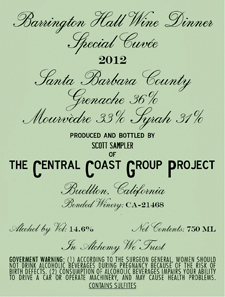 |
Scott brought over his wines for us to taste, starting with a 2012 GSM blend called “Barrington Hall Wine Dinner Special Cuvée.” It’s tough to really explain Berkeley’s Barrington Hall to anyone who didn’t experience it in person – like Scott, I’m a Berkeley grad from back in the day so I understand the reference. The name is a tribute to some pretty wild (OK, many of them went way beyond “pretty wild”) gatherings at the old student coop. The components for this wine were left on the skins for a long time – Mourvèdre and Syrah from Larner Vineyard were on the skins for 40 and 50 days respectively, and Grenache from Thompson Vineyard for about 60 days. Scott aged this wine entirely in neutral oak.
Next, we tasted three components for the 2012 CCGP “Names” Syrah, sourced from White Hawk Vineyard in Cat Canyon near Los Alamos. The “Names” bottling is a blend of three Syrah clones – 1, 174, and 877. All three were picked at the same time and made separately – in addition to the “Names” blend of all three clones, Scott will be releasing a limited set of all three separate clonal bottlings. The three-packs will be called “Variations on a Clone” – Scott described the concept as a “deconstructed field blend.”
|
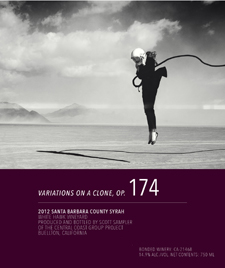 |
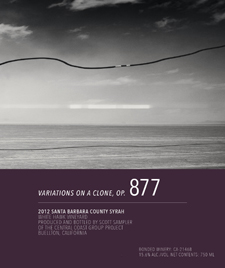 |
All three of the “Names” clonal components were made in similar ways. The Clone 1 component was fermented with 100% whole clusters and co-fermented with 15% Viognier, also from White Hawk Vineyard. The fruit for the Clone 174 and 877 components was entirely destemmed. All three of the clonal components underwent native yeast fermentation and 43-day maceration. The wine was barrel-aged in neutral oak for 18 months on the lees and a total of 20 months. After tasting each clonal component separately, we went on to taste the “Names” bottling of all three blended together – the overall blend included 5% Viognier and 30% whole clusters. Quite an fascinating winemaking exercise to launch a new label!
|
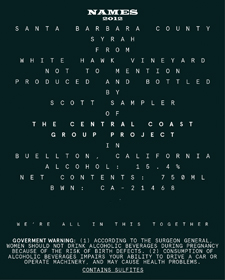 |
After we finished tasting with Scott, he took us to another space in Buellton Bodegas to check out his 2014 wines – in mid-January they were still on their skins in large bins and had not yet been pressed. Scott extended his macerations to as much as 120 days for his 2013 wines, and the 2014s had to have been approaching that when we saw them. The wines go through malolactic fermentation while still in the bins. Keeping the wines on the skins in open-top bins is a laborious procedure. The bins have to be very carefully sealed to protect the wine against oxygen. They’re opened each day just enough to be able to stir the wine and then cover it with inert gas before re-sealing. Scott feels that the extended time on the skins helps to tone down some of the wines’ upfront fruit character and allows more complex, earthy elements to develop, as well as giving the wines more structure for aging. The 2012 wines, even with their shorter maceration times (but still lengthy by most winemaking standards), developed some intriguingly complex aromatics.
Scott explained a bit more about his inspiration for using such long maceration times on his wines. He brought up some Italian wines he’d tasted that used the technique and that he thought were particularly striking. He felt they revealed a depth and purity that he didn’t find to the same extent in other wines. He also mentioned an analogy for extended maceration with cooking tomato sauce (which he said is an obsession of his) – the difference between a sauce that’s made quickly and one that’s cooked very slowly and carefully. Scott is in touch with his wine in the fermentation bins every day – stirring, tasting, and keeping tabs on the development of tannins and other phenolic compounds. It’s really winemaking by intuition and feel as much as or more than by chemistry – and as he acknowledges, it can be risky. But Scott feels that this method can do more to bring out the character of the site, vintage, and variety – in the end, it sounds like a spiritual and philosophical journey for him as much as a winemaking one.
Tasting the Central Coast Group Project wines with Scott was an unexpected bonus for our group. It was easy to see how excited he was to be pouring his new wines for us, and we had a good time talking with him. The very long extended maceration for his wines is unusual in California. I’ve seen a handful of other vintners use this technique, but generally only with one or two wines, not with all of them as Scott is doing. Scott’s 2012 wines were fairly big and bold, but with more complexity than you’d expect for that style. The 2012 “Barrington Hall Wine Dinner Special Cuvée” was a favorite, and I think the 2012 “Names” has potential but needs more time to develop in bottle. Of the three Syrah components, I preferred the Clone 174 bottling. Discovering a winemaker with such interesting ideas as Scott has was fun, and it will be fascinating to taste his 2013 and 2014 wines that stayed on the skins for much longer than the 2012s did. Part of Scott’s “Names” Syrah label seems to express his idea behind The Central Coast Group Project perfectly: WE’RE ALL IN THIS TOGETHER
Dragonette Cellars
Tasting Notes: Barrel Samples & Current Releases |
Dragonette 2014 Rosé, Vogelzang Vineyard, Happy Canyon of Santa Barbara (barrel sample). Made from about 70% Grenache, 27% Mourvèdre, and 3% Syrah, made in neutral barrels, to be bottled a few weeks after our visit. Very light peach color, with aromas of flowers, stone fruit, orangepeel, and herbs. Medium-light bodied and lively with a slightly chalky note on the crisp finish, nice.
Dragonette 2014 Sauvignon Blanc, Grassini Vineyard, Happy Canyon of Santa Barbara (barrel sample). Made in older oak. Very light straw color, this featured ripe melon and stone fruit, flowers, and an interesting hint of coffee on the nose. Medium-light bodied with a mildly creamy texture and a lively finish.
Dragonette 2013 Sauvignon Blanc, Grassini Vineyard, Happy Canyon of Santa Barbara. Light straw color, this had melon and tropical fruit aromas along with fresh herbs. Richer texture with a long, smooth finish.
Dragonette 2013 Sauvignon Blanc, Happy Canyon of Santa Barbara. Sourced from 50% each Grassini and Vogelzang vineyards. Light straw color, displaying grapefruit and stone fruit, fresh herbs, and a slight floral note. Medium-bodied with juicy acidity and a clean, crisp finish, nice.
Dragonette 2012 Sauvignon Blanc, Vogelzang Vineyard, Happy Canyon of Santa Barbara. Made in about 20% stainless steel and 85% oak (15% new). Light color, with a more tropical fruit profile along with touches of spice and sweet oak. Medium weight with a vibrant texture and long finish.
Dragonette 2012 Pinot Noir, Sta. Rita Hills. Sourced from six vineyards, about 7% whole-cluster fermentation. Medium ruby color, this was herbal and spicy, with black cherry and darker fruits, earth, and a touch of vanilla/oak. Medium-bodied, finishing with fine tannins.
Dragonette 2013 Pinot Noir, Duvarita Vineyard, Santa Barbara County (pre-release). From 113, 115, and 777 clones, biodynamically-farmed. Medium color, showing lots of spice and earth aromas plus intense red and black cherry fruit and a savory component. Medium weight in the mouth with lively acidity and a slight stony mineral note on the finish, nice.
Dragonette 2013 Pinot Noir, Radian Vineyard, Sta. Rita Hills (barrel sample). Medium color, with a darker fruit profile and lots of savory and spicy notes. Bigger and more structured on the palate, with a firmer tannic finish.
Dragonette 2012 Grenache, John Sebastiano Vineyard, Santa Barbara County. About 20% whole-cluster fermentation, aged in neutral puncheons. Medium-light color, this had bright strawberry fruit, spice, earth, plus hints of black pepper and dried herbs. Lively mouthfeel with fine and slightly chalky tannins, nice.
Dragonette 2012 “Seven,” Central Coast. 89% Syrah, 10% Grenache, 1% Viognier, from various Santa Barbara County vineyards plus Shadow Canyon in York Mountain AVA, aged in neutral oak. Dark purple color, featuring dark berry fruit, spice, coffee, and a floral note. Fairly rich mouthfeel with good structure and moderate tannins.
Dragonette 2011 “MJM,” Santa Barbara County. Barrel selection of 93% Syrah, 6% Grenache, 1% Viognier, sourced from four vineyards. Dark color, this had a more meaty, savory profile along with black fruits, earth, and touches of iron and pepper. Big and structured, this finished with grippy tannins – still needs time in the cellar but has great promise.
|
|
Our final winery stop of the day was only a few steps away from Buellton Bodegas, in the next building up the short street. Mike Roth walked us over, and our group was welcomed in by Brandon Sparks-Gillis of Dragonette Cellars. I’d actually met Brandon the same day in 2007 that I met Mike Roth – Brandon was working as the assistant winemaker with Mike at Demetria Estate at that time. Dragonette had moved into its Buellton facility in April 2013, after a number of years making their wines in Lompoc. Brandon told us that the building was one of the first purpose-built wineries in Santa Barbara County, and had been the original Sanford production facility. It’s also been used by Zaca Mesa, Loring, Cargasacchi, Clos Pepe, A.P. Vin, and others. I’d been in the building a couple of times in the past, but the most recent might have been back in 2003.
Brandon founded the winery along with two friends, brothers John and Steve Dragonette. Brandon is originally from Washington state, and studied geology in college. He and John met when both were working at Wally's Wine & Spirits, a well-known wine shop in Los Angeles, each drawn there by a love of fine wine. Brandon had already worked at a Colorado vineyard by that time, and both he and John gained winemaking and viticulture experience over the next few years – Brandon at wineries including Torbreck in Australia and Sine Qua Non in California, and John at Fiddlehead Cellars in Santa Barbara County and at Coastal Vineyard Care Associates, where he worked with noted vineyard manager Jeff Newton. Steve focuses mostly on the business side of the winery, though all three partners share in the winemaking.
The trio’s first foray into making wine was in 2003, with a single barrel they made in John’s garage in Hermosa Beach. 2005 marked the first commercial vintage of Dragonette, with a Syrah from Santa Ynez Valley. They added a Pinot Noir and Rosé the following year, and 2007 was the inaugural vintage for their “MJM” bottling – named for the initials of the partners’ wives’ names, it’s a selection of their best Syrah barrels. The first Sauvignon Blancs appeared with the 2008 vintage, and by 2009 the current Dragonette line-up was essentially complete, with the addition of Grenache and a Syrah-based Rhône-style blend called “Seven.” Brandon told us that they’re looking to add a Chardonnay in the future. Current annual production is around 6,000 cases.
Brandon started out by talking to us about Dragonette’s vineyard sources, and he pointed out the locations on a large map on the wall outside the winery office. They’ve worked with many growers over the years, mostly in Happy Canyon and Sta. Rita Hills, but Brandon told us that they have pared down the number of vineyard sources in the past five years or so. He showed us square glass jars with soil and rocks from their vineyards, and passed around a couple of larger rocks for us to check out – the geology major coming out in him! Dragonette sources Sauvignon Blanc from Grassini and Vogelzang vineyards in the warmer Happy Canyon appellation, while their Pinot Noir comes Fiddlestix, La Encantada, Cargasacchi, Radian, Bent Rock, and John Sebastiano vineyards, all in Sta. Rita Hills. Their Grenache and Syrah are grown at Harrison Clarke and Stolpman vineyards in Ballard Canyon, Thompson Vineyard near Los Alamos, and John Sebastiano Vineyard.
Brandon led our group back through the winery and we sat at a table in the barrel room to taste some of the current Dragonette releases along with a few barrel samples. We started out with a sample blend of their 2014 Rosé, made from Grenache and Mourvèdre specifically farmed for Rosé and from Syrah saignée, all fermented and aged in neutral oak – this was scheduled to be bottled a few weeks after our visit. Brandon noted that 2012 through 2014 have all been very good vintages in Santa Barbara County. He also mentioned that the 2014 vintage wines were all fermented with native yeast.
Our next wine was a barrel sample of 2014 Grassini Vineyard Sauvignon Blanc from a neutral barrel, and we proceeded from there to taste 2013 Sauvignon Blanc bottlings from Grassini and a Happy Canyon appellation wine that’s a 50/50 blend of Grassini and Vogelzang vineyards, and a 2012 from Vogelzang. Brandon told us that he, John, and Steve had wanted to make Sauvignon Blanc from the start, but had to wait until they had access to the vineyards they wanted. The 2013 Happy Canyon bottling was barrel-aged for eight months, and Brandon said he feels their Sauvignon Blancs tend to pick up more tropical fruit character with some age. He also finds that aging them in larger format barrels slows their development, bringing them closer to wines aged in stainless steel than in smaller barrels.
We moved on to reds, starting with a trio of Pinots. First was the 2012 Sta. Rita Hills appellation bottling, sourced from John Sebastiano, La Encantada, Fiddlestix, Zotovich, Radian, and Bent Rock vineyards. We tasted a Pinot that will be released this spring, the 2013 from Duvarita Vineyard (formerly Presidio). Located just outside the western boundary of Sta. Rita Hills near Lompoc, it’s farmed biodynamically on very sandy soil. Brandon then pulled a barrel sample for us, their 2013 Pinot from Radian Vineyard, in the far southwest corner of St. Rita Hills off of Santa Rosa Road, situated on diatomaceous soil.
Our last three wines were all from Rhône varieties. The 2012 Grenache was sourced from John Sebastiano Vineyard – it’s labeled as Santa Barbara County because the vineyard actually straddles the eastern boundary of Sta. Rita Hills. Brandon noted that their fruit comes from a block where there are two different soil types – clay loam on the upper slopes with sand on the middle and lower portion. Due to how the soil types affect the fruit ripening, these two sections of the block are always picked separately. The fruit was fermented with about 20% whole clusters and the wine was aged in neutral puncheons. The fruit for the 2012 “Seven” was sourced partly from Shadow Canyon Vineyard in the small York Mountain AVA in the mountains west of Paso Robles. The 2011 “MJM” fruit came mostly from John Sebastiano and Stolpman vineyards, as well as some from Harrison Clarke and Thompson. This wine receives longer barrel and bottle aging prior to release than their other reds.
I think everyone in our group agreed that our tasting with Brandon at Dragonette was one of the best of the weekend. The wines were strong across the board, with my favorites being the 2014 Rosé barrel sample, the 2013 Happy Canyon Sauvignon Blanc, 2013 Duvarita Vineyard Pinot Noir, and 2012 John Sebastiano Vineyard Grenache, with the 2011 “MJM” showing lots of promise but needing more time. I liked the analogy that Brandon shared with us about different Pinot vineyards being like “voices in a choir.” Each displays a different character depending on the vineyard soil, whether it’s a warmer or cooler site, etc., but they can join together into a harmonious whole, such as in Dragonette’s Sta. Rita Hills Pinot, sourced from six vineyards. Of course it takes skill to create such a blend, and Brandon, John, and Steve have shown over the years that they’re as good with blends as with single-vineyard and single-varietal wines. As the Dragonette label enters its second decade, the wines continue to be among Santa Barbara County’s best.
After a quick stop back at the timeshare in Solvang, we made the short drive for dinner at the Hitching Post II restaurant in Buellton. We were joined there by John Tomasso, Karen Steinwachs of Buttonwood Farm Winery, and Brian Loring and his assistant winemaker Rachel Silkowski (who also makes her own Rasi Pinot). Monday at Hitching Post means burger night in the bar area – terrific burgers but they don’t take reservations for the bar area so we had to wait about 20 minutes. During that time we ran into still more people we knew – both Gregg Greenbaum and Bobby Moy happened to be at the restaurant that evening. Of course all of us brought wine – Eric counted 17 bottles that we opened at the table. Karen, Brian, and Rachel each brought bottles of their own wines to share – I didn’t take notes, but I’ve added brief impressions of the wines under the Loring and Buttonwood sections of this report. John, as he often does at these dinners, brought an older Riesling – that night it was a tasty 1999 Mosel, Joh. Jos. Christoffel Erben Ürziger Würzgarten Auslese. Before long, we were enjoying our juicy burgers and crisp fries, and we all had a great time.
Eventually it came time to say good-bye to everyone after dinner, and then it was back to the timeshare for our group. We all got together to relax for awhile and finish off a couple of bottles of wine that were left over from the previous night, and then it was time to start getting things ready to go for the final day of our Central Coast wine tour the following day.
|



